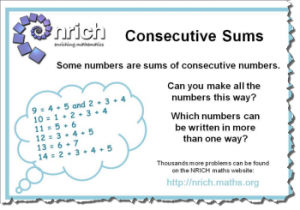Consecutive sums
Lesson idea. This resource provides a detailed consecutive sums activity with extension work.
Teaching approach. By definition, a problem is something that you do not immediately know how to solve, so learning how to solve something unfamiliar is not straightforward. Tackling an extended problem is difficult.
This lesson gives pupils an opportunity to engage in mathematical thinking(ta) and develop their higher order(ta) thinking skills on a problem that is accessible but which has interest. For example, the problem is presented in diagrammatic and numerical ways.
The plan suggests several visualisation(ta) methods to present the same underlying task. It should be useful for teachers to compare these different presentations and either to select the one that they feel will be most useful for their pupils or explore ways for the pupils to see the links between the different methods. The assessment(ta) ideas, using other pupils' solutions from the NRICH website are widely applicable to other problems too. (edit)
| Resource details | |
| Title | Consecutive Sums |
| Topic | [[Topics/Investigation|Investigation]] |
| Teaching approach | [[Teaching Approaches/Assessment|Assessment]], [[Teaching Approaches/Higher order|Higher order]], [[Teaching Approaches/Mathematical thinking|Mathematical thinking]], [[Teaching Approaches/Visualisation|Visualisation]] |
| Learning Objectives | Allowing pupils to:
|
| Format / structure | Word document and wiki page and an extension activity. |
| Subject | [[Resources/Maths|Maths]] |
| Age of students / grade | [[Resources/Secondary|Secondary]], [[Resources/KS4|KS4]], [[Resources/KS3|KS3]]
|
| Files and resources to view and download | Consecutive sums activity (on the wiki) or File:Consecutive sums Activity.doc (as a downloadable Word document) and File:Steps activity.doc |
| Acknowledgement | This resource was adapted from resources contributed by Mark Dawes |

